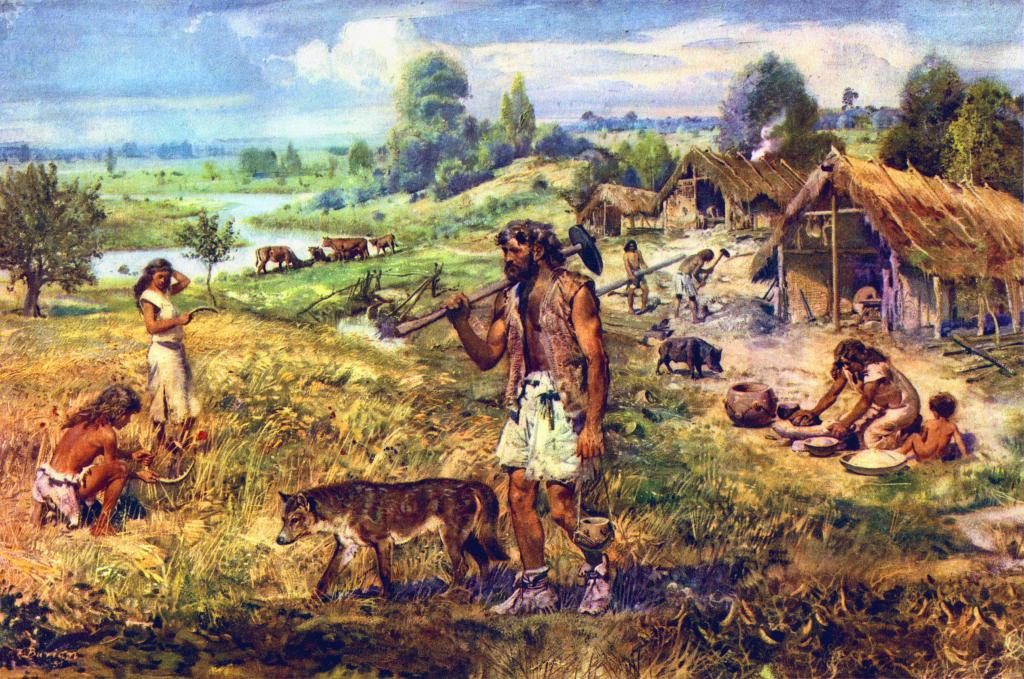Early humans before the neolithic era lived in small nomadic communities. Certain prehistoric communities started to make their own innovations regarding tools. They were able to start domesticating animals and growing plants for use, which would in turn allow them to start living in villages, or larger groups. The Neolithic Age was a period in the development of human technology, beginning about 10,000 BCE, in some parts of the Middle East, and later in other parts of the world, and ending between 4,500 and 2,000 BCE.
In earlier periods of time, people usually lived in non-permanent structures, such as tents, that could be picked up and transported very easily. Now with the development of agriculture, technology and the inventions of more sophisticated tools used in agriculture, people of the Neolithic Era were able to build permanent shelters. This gave them the ability to grow crops in the surrounding area. People started to develop their control over fire, which allowed for different uses soon after this. One of these uses of fire was the early stages of pottery. Humans began to dry clay for uses around the household. Hunting also became much easier to accomplish with the introduction new of stone tools. The most common tools used were daggers and spear points, used for hunting, and hand axes, used for cutting up different meats, and scrappers, which were used to clean animal hides.1

Advances in tool-making and domestic technology led to advances in agriculture. Farming started a revolution in the world and helped set us on a path that would eventually lead to the technological revolution and invention of different things. Inventions such as the plow helped in the planting of seeds. One essential benefit of the development of farming technology was the possibility of producing surplus crops, or food supplies that surpassed the immediate needs of the community. Surpluses could be stored for later use, or possibly traded for other necessities or luxuries. Agricultural life afforded securities that nomadic life could not, and farming in one place resulted in population growth far beyond that of hunters and gatherers. Soon after plant domestication began, animal domestication followed. The raising of cattle, sheep, and pigs for food replaced the necessity of daily hunting. The creation of stone tools also helped to advance the making of clothing. It was now possible to sheer wool and spin it into yarn to make more advanced clothing that made for better protection against the elements.2
Agriculture during this time period gave the human species a new feeling of security that their past way of life could not. However, this new way of living created new problems within the communities. Famines and pests yielded new diseases that the people of this era had not seen before. Sanitation became a problem due to the fact that most primitive villages did not have a proper form of waste disposal. Due to the fact that agriculture led to technological innovations it can be said that the Neolithic Era was the catalyst for the future of technology.3
- M.P. Richards, “A Brief Review of the Archaeological Evidence for Palaeolithic and Neolithic Subsistence,” European Journal of Clinical Nutrition 56, no. 12 (2002): Published Online. ↵
- Melanie Boyd, “The different paths of the neolithic revolution in Egypt and Sudan,” Anthrojournal Vol. 2 May 2014, Published Online. ↵
- Hugh James Freeman, “The Neolithic Revolution and Subsequent Emergence of the Celiac Affection,” International Journal of Celiac Disease 1, no. 1 (2013): 19–22. ↵



28 comments
Nicolas McKay
This was an awesome article Desmond! Its incredible to think how much life changed for the neolithic people after leaving their nomadic lifestyles behind in order to adopt a more permanent settlement. The tools they required while they were nomads were certainly small in number, so its incredibly to see the advancements they were able to make. It truly show how adaptable and determined human beings can be. great job again.
Christian Lozano
It is interesting to see how the Neolithic Era ways still last up to this day, especially with Farming and Agriculture. In reality, property and the mustard seed of Capitalism was planted by the advancements in the Neolithic Era. Non-nomadic living is basically what we follow to this day, buying a house or property and staying for an extended period of time.
Maalik Stansbury
The way humans had to adapt is pretty incredible. The interesting is that it ends up being a thing humans do automatically, no matter where they are presented or put at. In a way it is a survival technique. I do enjoy how you structured your article in a way that is best fitting in explaining the adaption and equipment as well as how the humans came to be.
Analina Devora
I find it very interesting how humans back then had to basically do EVERYTHING from scratch. If the human race today was put in that situation the survival rate would be very low. However, agriculture is still a very important part of our lives and is often overlooked which is a shame.
Andres Palacios
Excellent article, Agriculture has been a very important part and a key component in most civilizations. We have seen the effect it had in the Neolithic Era and the effect it has now in our communities and how it has developed through the years.
Mehmet Samuk
I have always been interested in Neolithic Era and those kind of early histories. Most of the tribes from these time periods were living in Turkey, in Anatolia. I remembered visiting museums and seeing those artifacts back home while reading your article. Good job !!
Yesenia Cardenas
It is amazing to see how far the human species has adapted from the beginning of the time. From living in tents and using small tools to now living in structures able to sustain a hurricane. This is a good article and is very informative.